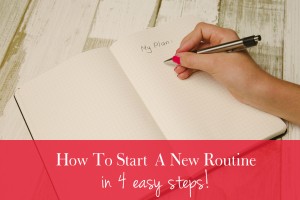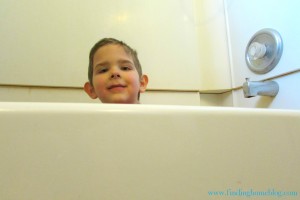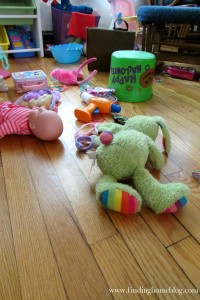Sometimes I get stuck in a rut. We’ve been doing things the same way for months (whether it’s working or not), and it can be hard to try doing them differently. But sometimes, a change is necessary.
Whether you have very strict times for certain activities in your day, or you have a rhythm but not specifics, or you’re totally spontaneous with what gets done when, if you want to start a new routine, this is for you.

photo credit from pexels.com
Here’s how to start a new routine:
Step 1: Identify the problem. What isn’t working? If you have a routine going, but something is stressing you out, or something just isn’t working, nail down what the problem is. Or if you don’t have a routine in place, maybe the problem is that you want more organization in your life or schedule.
Step 2: Identify your goal. Where do you want to end up? In an ideal world, on a perfect day, how would this perfect thing work?
Step 3: Write down the steps to get there. Between point A and point B, there are probably a few kinks to work out. Now that you have a goal in mind (step 2), how can you get there? Try to think outside the box, because if something isn’t working, continuing to do the same thing over again probably won’t help.
Step 4: Break those down into smaller steps. After you have come up with a few basic steps to get from your problem to your new routine, break those steps down into even smaller steps.
We experienced this firsthand recently. Saturday night was bath night for the kids. (Sometimes they take baths in the middle of the week if they’re stinky, but we always clean up on Saturdays for church). But the evening went something like this: Cook dinner, eat dinner, clean up dinner, do dishes, pick up toys, bathe four kids, pajamas, brushing teeth, prayers, yell, get mad, scream, collapse, all within about a 90 minute window. It was stressful, I hated it, and that stress wore off on the kids.

Step 1: The problem was that we were cramming too many things into a small time period.
Step 2: Ideally, everything gets cleaned up, including the children, without the stress. We need more time. When do we have more time? In the morning. That was my light bulb moment.
Step 3: In order to switch baths to the morning, I need to remember to bathe the kids after breakfast before they go off and get dressed, and everyone scatters to do things. In order to make the evenings less stressful, let’s try picking up toys before dinner (this ended up being it’s own switched routine – we pick up the dining room and kitchen before dinner so we have a clean eating space, and the living room afterwards).
Step 4: I needed reminders! I drew a big bathtub on our whiteboard in the dining room so we would see it while eating breakfast. I put the bath soap on the bathroom counter. I told the kids to remind me and made a big deal about how fun it would be to take baths in the morning and have time to play in the water. And guess what? It worked!
We successfully switched our stressful nighttime bath routine to a calm, relaxed morning routine by following these steps. In this case, I simply thought things through. You might find it helpful to list everything out with a pen and paper, especially if you’re tackling a bigger project.

Or maybe you can relate to this: We have too much stuff in our house. We’ve started KonMari-ing everything, but have stalled on our progress lately. Here’s how I’m approaching this one:
Step 1: The problem is that we have too much stuff, specifically in our living room area, which now houses the toys, the craft supplies, and general family hanging out area.
Step 2: Ideally, everything has a place. There isn’t constant stuff lying around, because it’s easy to see where it goes, and there’s just less of it.
Step 3: We need to go through toys and get rid of a bunch. We need to go through craft supplies and pare down to what we will actually use. We need to find homes for random things like video game cords and dvds and magazines and everything else that lives here.
Step 4: This is where I’ve made a list of each area I mentioned in step 3. For craft supplies, it looks like this:
- Go through coloring books. Pare down to 2 per child.
- Go through paper supplies. Make it fit in the paper holder that’s in there, and put extra somewhere not accessible (Elizabeth and Hannah keep pulling extra paper out of the box on the floor where it’s currently sitting)
- Go through Mom’s shelf (the top shelf where I have things like glitter glue and special paper punches, which the kids don’t use without permission).
- Find containers that work. We have little bins and boxes in there for some things, but a lot of the stuff just gets thrown back in without much order. Notice this happens after getting rid of things.
I have separate lists like this for each area of the living room that we want to work on.
I got this four-step idea from a webinar I watched recently from Nick Stephenson and David Garland. The webinar was actually on how to develop your own online courses, but I think these steps really transfer over well into other areas of our lives. By thinking through the process and identifying the problem and the goal, we can then easily figure out what steps to take to get from one to the other.
Good ideas, Katy! What you described are things we are constantly dealing with, too. Good tips to make things work better for everyone!